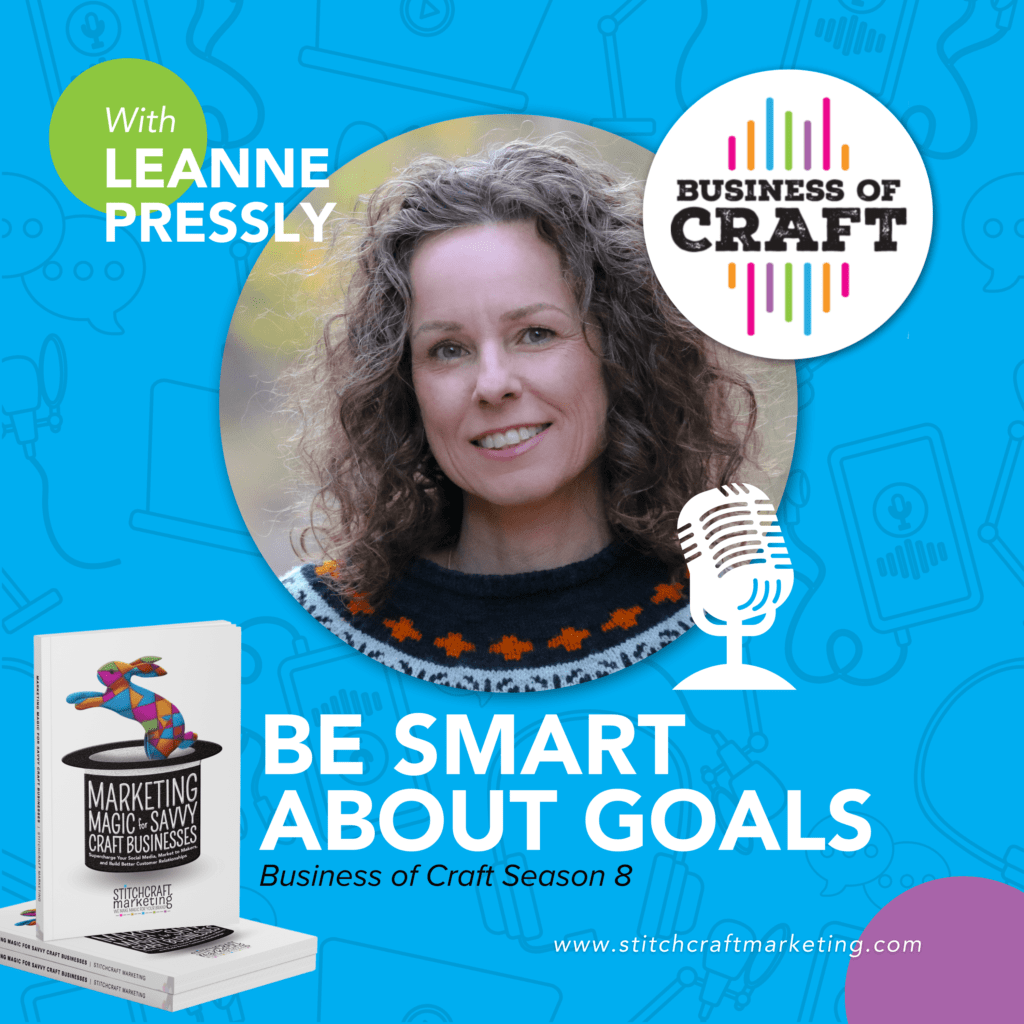WELCOME TO SEASON 8 OF BUSINESS OF CRAFT
Welcome to Business of Craft, a show designed to help entrepreneurs with fabric or fiber businesses become more successful.
This is our 8th season of BOC and today we have another solocast to cover one of the topics in our new book, Marketing Magic for Savvy Craft Businesses. I’m super proud of this book which my whole team wrote in 2025. The book is available for sale in Kindle and print version (and soon to be audio) on our website or Amazon.
Listen to the Show:
Listen to it on Spotify, iHeartRadio, iTunes, and PlayerFM,
Thank you for taking the time to listen! If you’re enjoying the show, it’s safe to assume there are others out there like you who would also enjoy the show. Help them find it by leaving a review on your favorite podcast platform. Don’t forget to subscribe to stay on top of the latest episodes!
Hey there, craftpreneurs — it’s Leanne here, and I want to start today with a simple but powerful question:
What are you working toward in your business right now?
Not just surviving or winging it. I mean real, tangible, measurable goals.
If you just had a little internal panic moment or said, “Ugh, I should be better about goal-setting,” you’re not alone. Most craft business owners are wildly passionate, deeply creative, and yes — sometimes allergic to spreadsheets and strategy. I get it!
But here’s the truth: if you don’t know where you’re going, it’s really hard to get there. And without getting too woo woo on you, I’ll just remind you that there are plenty of people who will say that manifesting is a powerful tool in the universe and that writing things down helps that whole process happen.
I asked the googler for some research to back this up and found this study from Gail Matthews, Dominican University (2007): In a study of nearly 270 participants, people who wrote down their goals and shared them with a friend were 33% more successful in accomplishing them than those who only formulated goals mentally.It wasn’t just goal setting—it was the act of writing that made a difference.
We know that Writing (especially reflective journaling) activates the prefrontal cortex, the brain’s decision-making and planning center.
In another study: Peter Gollwitzer (1999) showed that forming specific plans—”If X happens, then I’ll do Y”—increased the likelihood of goal completion.
Dr. Jordan Peterson (University of Toronto): His Self Authoring Suite research showed that people who wrote out plans and reflections significantly improved academic performance and reduced dropout rates. Why? Writing clarifies priorities, reduces cognitive load, and turns abstract intentions into concrete actions.
That’s why in Chapter 6 of our book, we dive into setting SMART goals — and even better, SMARTER goals.
Let’s break it down:
SMART is an acronym. You’ve probably heard it before:
-
S is for Specific
-
M is for Measurable
-
A is for Achievable
-
R is for Relevant
-
T is for Time-bound
So instead of saying “I want to grow my business,” a SMART goal would be:
“I want to increase my online sales by 20% over the next 6 months by running a targeted email and social media campaign.”
See the difference? One is a wish. The other is a plan.
Now, here’s where we take it a step further. We add the E and the R:
Let me give you a real-world example from one of our clients:
They had a goal to “grow their newsletter list.” Vague, right? We helped them rework it into a SMARTER goal:
“Add 300 new qualified subscribers to our email list by the end of Q2 by offering a free downloadable pattern in exchange for signup and promoting it through Instagram and a cross-promo with a complementary brand.”
Once they did that, they knew what success looked like. They had a deadline. And they had a clear strategy.
I also see so many clients fall short on the back end of goal setting. They can set the goals using the SMART structure but then they forget to check their analytics to see if they achieved the goals. In our 2023 research study of craft retailers, we specifically asked how many of you are checking analytics. And can you guess that number? Only 14% were collecting data and only 4% were actually utilizing data to inform your marketing strategy.
So, if you had this goal of adding new subscribers, you have to go into the back end of your email platform and track that goal and make a note of whether you did nor didn’t achieve it.
So, how can you apply this?
Here’s your reflection exercise for this week:
-
Pick one area of your business — maybe it’s social media, email marketing, in-store events, or product development.
-
Set one SMARTER goal for the next 90 days.
-
Write it down. Share it with a teammate or a peer. Track your progress.
And if you’re not sure where to start, here are a few common basic goals we help clients with- and remember with these, you have to fill in the specifics part of the SMART sequence…
-
Increase average order value by $10 in the next quarter- (and I’ll let you know we have a blog post on steps to do this we just published on our blog at stitchcraftmarketing.com/blog
-
Secure 100 participants for our Fall Bernina Event.
-
Build a Facebook group and grow to 500 members by year-end
-
Collaborate with 3 influencers in the next 90 days
The important thing is to make your goals visible and actionable. Post them somewhere you’ll see them. Incorporate them into your regular staff or team meetings so hold yourself accountable.
Because when you shift from “I hope this works” to “I’m tracking progress every week,” you step into a whole new level of leadership in your business.
You become more intentional. More strategic. And ultimately — more successful. Your marketing becomes more magical!
If you have our book, page 168 and 169 has the worksheets you can use to write out your SMART goals step by step.
If you haven’t picked up a copy of the book, you can go to our website stitchcraftmarking.com/magic and order either print or kindle edition there.
Thanks for listening and we’ll see you next time on Business of Craft.


